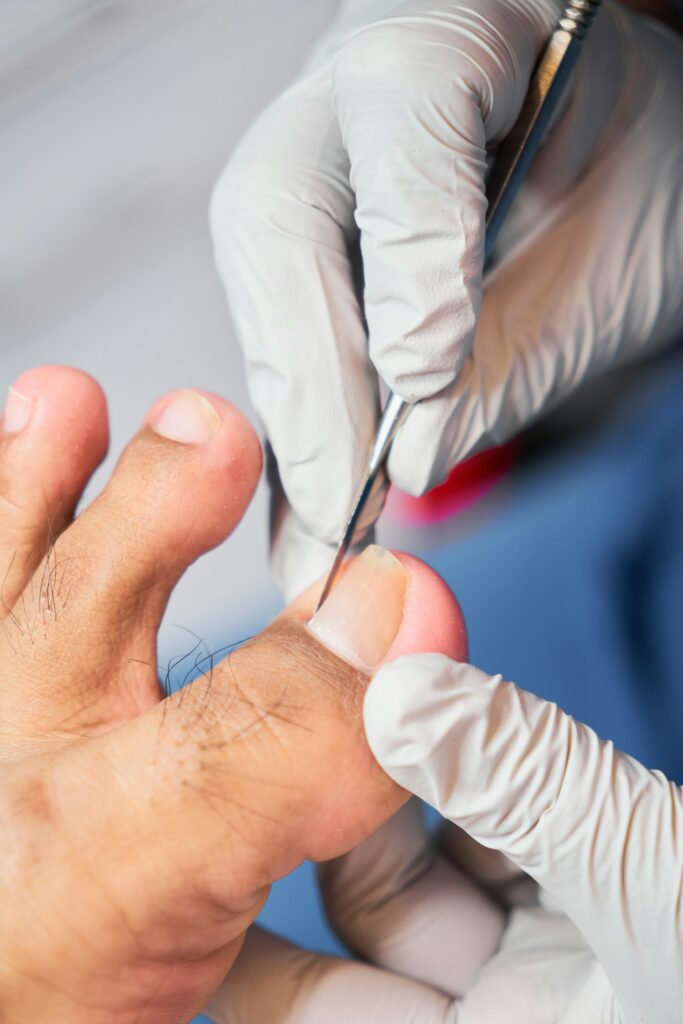Table of Contents
Ingrown Toenail Treatment in the Salt Lake City area of Utah
Ingrown Toenails
To receive treatment for an ingrown toenail, make an appointment at Advanced Foot & Ankle Center by calling the nearest office Ingrown toenails are one of the most dreaded foot issues people don’t want to have. Besides the negative social stigma of ingrown toenails, there can be pain, discomfort, infection and often an unsightly appearance attached as well.
The biggest cause of ingrown toenails is easily preventable. Cutting your toenails too short and cutting them in a way where the two corners are tapered is the biggest culprit in causing ingrown toenails. The second most common cause of ingrown toenails is wearing shoes that are too short or too tight.
Ingrown toenails are when your toenail begins to grow into your skin. If not treated, it can lead to severe pain, infections and even surgery.
Ingrown Toenail Symptoms
Any of your toe nails can become ingrown. In most cases, however, it’s one of the big toes that become ingrown. Symptoms of ingrown toenails include:
- Redness
- Hardness
- Swelling
- Tenderness
- Pain
- Draining pus
If you notice any of these symptoms, it is important to treat it immediately. Early prevention and treatment can be done at home. If treatment is ignored or postponed, further, more extensive professional treatment will likely be needed.
Ingrown Toenail Treatment
Nonsurgical Treatments
In the early stages, you can easily treat an ingrown toenail at home. Below are some at-home treatments:
- Soak your foot 3 times a day in warm water.
- Keep your foot as dry as possible when you’re not soaking them.
- Wear comfortable shoes that have plenty of room for your toes.
- Take ibuprofen or acetaminophen if you’re experiencing pain.
Surgical Treatment
If severe pain, swelling, inflammation and discharge persists, the toenail is likely infected. At this point, it is important you make an appointment with one of our podiatrists. Toenail surgery may be necessary. During this procedure, a part of the infected nail will be removed. In extreme cases, the whole nail may be removed.
If you’re ingrown toenail is causing you persistent pain and swelling, call us today to make an appointment. At Advanced Foot & Ankle Center, we care about the health of your feet. Your feet are important and any kind of pain or discomfort can negatively affect your life. Our certified podiatrists use the latest technology and will do whatever is necessary to avoid surgical treatment for your ingrown toenail.
What Should You Do Next?
Watch This Video from Dr. Clegg to Learn more about the Procedure
Ingrown Toenail FAQs
What is an ingrown toenail?
An ingrown toenail occurs when your nail grows into the skin around the nail bed, instead of out and away from your toe.
Without early intervention and treatment, an ingrown nail can become infected. If you have diabetes or venous insufficiency, that increases your risk of gangrene or amputation.
What are the symptoms of an ingrown toenail?
- Redness
- Swelling
- Tenderness
- Warmth
If your toenail develops an infection, it might also ooze pus.
What causes ingrown toenails?
Ingrown toenails occur for various reasons, including:
- Wearing tight shoes
- Cutting your toenails at an angle
- Stubbing your toe
- Having abnormally curved nails
There’s no way to prevent an ingrown toenail entirely, but you can significantly lower your risk by inspecting your feet daily and wearing shoes that give your toes plenty of room to move around.
How is an ingrown toenail diagnosed?
How is an ingrown toenail treated?
Often, ingrown toenails respond to at-home treatments like soaking the nail in warm water, wearing comfortable shoes, and taking over-the-counter pain medication. If your symptoms persist or get worse, Advanced Foot & Ankle Center might recommend:
Lifting the nail
If your toenail is red and only slightly irritated, your provider might lift it with a splint. Lifting the nail allows it to grow out and away from your toe.
Partially removing the nail
If your nail is infected and oozing pus, your provider might remove part of it. After removing the damaged portion of your nail, they apply a topical antibiotic to prevent infection and encourage your body’s healing process.
Completely removing the nail
If you experience a recurring ingrown toenail, your provider might recommend removing the nail altogether. To do that, they numb your toe with an anesthetic and surgically remove the nail. Following surgery, your provider writes a prescription for oral antibiotics.
At Advanced Foot & Ankle Center, the podiatrists use the latest technologies that are safe, effective, and provide lasting relief.
What Should You Do Next?
Looking to schedule an appointment with a physician?
Call Advanced Foot and Ankle Center or book an appointment online today for effective solutions to your painful ingrown toenails.


